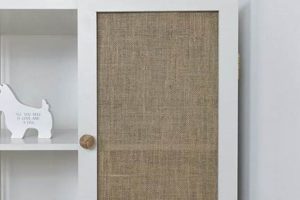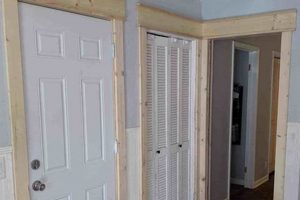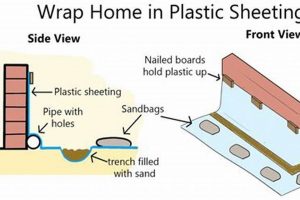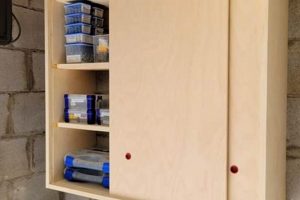The process of constructing cabinet fronts with a specific, minimalist design, undertaken as a do-it-yourself project, involves several key steps. Typically, this involves creating a five-piece door consisting of a flat center panel surrounded by a frame. This frame is commonly constructed from four pieces of wood: two stiles (vertical pieces) and two rails (horizontal pieces). The center panel can be made from plywood or MDF (medium-density fiberboard). Successful execution requires precision cutting and joinery techniques.
Undertaking this type of cabinet project offers numerous advantages. It represents a cost-effective alternative to purchasing pre-made cabinet fronts, enabling significant savings. Furthermore, it allows for complete customization of dimensions, materials, and finishes to match existing decor or specific design preferences. The style itself has enduring appeal, fitting seamlessly into a range of interior design schemes from traditional to contemporary. Historically, this design emerged from the Shaker movement, known for its emphasis on simplicity, utility, and craftsmanship.
The subsequent sections will provide detailed guidance on material selection, precise cutting techniques, secure assembly methods, and appropriate finishing options for achieving professional-quality results. Emphasis will be placed on both hand tool and power tool approaches to cater to varying skill levels and available equipment.
Essential Considerations for Undertaking Cabinet Door Construction
The following guidelines are provided to optimize the outcome and ensure the durability of self-made cabinet doors. Careful adherence to these points will mitigate potential challenges and contribute to a successful project.
Tip 1: Material Selection is Paramount: Consider the environment in which the cabinets will be installed. For moisture-prone areas, such as kitchens and bathrooms, select water-resistant materials like MDF or marine-grade plywood for the center panel. Hardwoods such as maple, oak, or cherry are recommended for the frame due to their durability and aesthetic appeal.
Tip 2: Precision in Measurements and Cuts: Accurate measurements are crucial. Ensure all cuts are square and consistent. Employ a high-quality table saw or miter saw with a sharp blade to minimize tear-out. Prior to assembly, dry-fit all components to verify accuracy and identify any necessary adjustments.
Tip 3: Secure Joinery Techniques: Mortise and tenon joints, rabbet joints, or pocket hole joinery can be used to assemble the frame. Regardless of the chosen method, ensure the joints are strong and properly aligned. Apply wood glue liberally to all mating surfaces and clamp securely until the adhesive has fully cured.
Tip 4: Proper Panel Insertion: Allow for slight expansion and contraction of the center panel by providing a small gap within the frame. This can be achieved by using rubber spacers or leaving a slight recess when routing the groove for the panel. Failure to do so can result in cracking or warping of the door.
Tip 5: Sanding and Surface Preparation: Thoroughly sand all surfaces prior to finishing, starting with a coarse grit sandpaper and progressively moving to finer grits. Pay particular attention to edges and corners to remove any sharp edges or imperfections. Ensure the surface is clean and free of dust before applying any finish.
Tip 6: Appropriate Finishing Application: Select a finish that is appropriate for the chosen wood and desired aesthetic. Consider using a primer or sealer to improve adhesion and create a uniform base for subsequent coats. Apply multiple thin coats of finish, allowing each coat to dry completely before applying the next. Lightly sand between coats for a smoother final finish.
Tip 7: Hardware Considerations: Select cabinet hinges and pulls that complement the style of the doors and are appropriate for the weight and size of the doors. Ensure proper alignment of hinges and pulls to ensure smooth operation and prevent premature wear. Use appropriate screws or fasteners for secure attachment.
Adhering to these essential considerations will significantly enhance the quality and longevity of handcrafted cabinet fronts. Attention to detail throughout the construction process is paramount to achieving a professional and aesthetically pleasing outcome.
The following sections will address common pitfalls and troubleshooting techniques to further refine the process.
1. Material Selection
Material selection is a foundational element in the endeavor of constructing cabinet fronts, influencing both the aesthetic outcome and the longevity of the finished product. The choice of materials significantly impacts the structural integrity, resistance to environmental factors, and overall visual appeal.
- Wood Species and Frame Construction
The species of wood selected for the frame determines the door’s durability, grain pattern, and susceptibility to damage. Hardwoods like maple, oak, and cherry offer increased resistance to dents and scratches, making them suitable for high-use areas. Softwoods such as pine are more cost-effective but may require additional surface protection. The frame material also affects the joinery options, as certain woods are better suited for specific joint types like mortise and tenon or pocket hole joinery.
- Center Panel Material and Stability
The center panel material significantly contributes to the dimensional stability of the door, particularly in environments with fluctuating humidity levels. Solid wood panels can expand and contract, potentially causing warping or cracking if not properly accounted for in the design. Engineered wood products, such as medium-density fiberboard (MDF) or plywood, offer greater stability due to their consistent composition and reduced susceptibility to moisture-related movement. However, the edge treatment and finishing requirements differ between solid wood and engineered wood options.
- Moisture Resistance and Environmental Factors
In environments prone to moisture, such as kitchens and bathrooms, the selection of moisture-resistant materials is paramount. MDF is often preferred for painted cabinet doors in these areas due to its ability to resist warping and swelling when exposed to humidity. For stained finishes, marine-grade plywood or hardwoods with a naturally high oil content, such as teak, may be considered. The selected material must be compatible with the intended finish to ensure proper adhesion and long-term protection against moisture penetration.
- Finish Compatibility and Aesthetic Considerations
The chosen finish, whether paint, stain, or a clear coat, must be compatible with the selected material. Certain woods, such as pine, may require a pre-stain conditioner to ensure even stain absorption. MDF requires a specialized primer to seal the surface and prevent the finish from being absorbed excessively. The material’s grain pattern and natural color also influence the final aesthetic. For instance, a heavily grained oak may not be suitable for a smooth, modern finish, while a fine-grained maple is often preferred for painted cabinets.
The interplay between material selection and the desired outcome necessitates careful consideration. The selection of frame and panel materials, their inherent properties, and their compatibility with the intended finish collectively determine the structural integrity, aesthetic appeal, and long-term performance of cabinet fronts.
2. Precise Measurements
Accurate dimensional assessment is a critical prerequisite for successful cabinet door construction. Deviations from specified dimensions during the initial measurement phase propagate errors throughout the fabrication process, potentially resulting in ill-fitting components and compromised structural integrity.
- Frame Component Dimensions and Joinery Alignment
The stiles and rails forming the door frame require accurate length measurements to ensure square and symmetrical assemblies. Inaccurate measurements introduce cumulative errors, leading to misaligned joints and skewed door profiles. For instance, a stile that is even slightly shorter than specified will result in a visibly uneven door and difficulty in subsequent installation. The internal dimensions created by the frame directly dictate the size of the center panel; imprecision at this stage mandates compensatory adjustments later, potentially compromising the aesthetic.
- Center Panel Sizing and Frame Groove Accommodation
The dimensions of the center panel must be precisely calculated to fit within the frame, accounting for expansion and contraction. If the panel is oversized, it will not fit properly, forcing adjustments to the frame or panel. Conversely, an undersized panel will result in excessive gaps, compromising the visual appeal and structural integrity. Measurements must consider the depth and width of the grooves routed into the frame to accommodate the panel, ensuring a secure and flush fit.
- Overall Door Dimensions and Cabinet Opening Compatibility
The final dimensions of the assembled door must conform to the specifications of the cabinet opening. A door that is too large will not fit, necessitating trimming or complete reconstruction. A door that is too small will leave unsightly gaps. Accurate measurements of the cabinet opening, including consideration of hinge placement and reveal allowances, are imperative to ensure proper fit and functionality.
- Hardware Placement and Alignment
Precise measurements are required for hinge placement and pull/knob installation. Incorrect measurements can lead to misaligned doors, binding hinges, and asymmetrical hardware placement. Hinge placement must be consistent across all doors within a cabinet set to ensure uniform operation. Similarly, knob and pull placement should be consistent to maintain visual harmony and ergonomic accessibility.
The integration of precise measurements throughout the door construction process represents a fundamental aspect of achieving professional-quality results. Accurate measurements contribute directly to the functionality, aesthetic appeal, and long-term durability. Careful attention to measurement protocols minimizes waste, reduces the likelihood of rework, and ultimately enhances the value of the finished product.
3. Secure Joinery
The structural integrity of cabinet fronts, particularly in do-it-yourself contexts, is fundamentally dependent on the employment of robust joinery techniques. The long-term performance and aesthetic quality hinge on the selection and execution of appropriate methods for connecting the frame components and securing the center panel.
- Mortise and Tenon Joints and Frame Rigidity
The mortise and tenon joint, a traditional woodworking method, involves inserting a projecting tenon from one piece of wood into a precisely cut mortise in another. This joint offers exceptional strength and resistance to racking forces, crucial for maintaining the squareness of cabinet doors over time. Its application in cabinet front construction ensures long-term stability and prevents warping or sagging, especially in larger doors. Variations, such as the through tenon or blind tenon, offer different aesthetic and structural properties. A properly executed mortise and tenon provides a mechanical interlock, supplemented by adhesive, that distributes stress effectively.
- Rabbet Joints and Panel Retention
A rabbet joint, characterized by a recess cut along the edge of a piece of wood, facilitates the secure retention of the center panel within the frame. This joint type provides a larger glue surface area compared to other methods, enhancing the bond between the frame and panel. The rabbet joint allows for slight panel expansion and contraction, mitigating the risk of cracking or warping due to humidity fluctuations. Accurate cutting of the rabbet is essential to ensure a snug fit that prevents panel rattle or displacement. While robust, this joint is often augmented with glue and, in some cases, mechanical fasteners for enhanced durability.
- Pocket Hole Joinery and Frame Assembly
Pocket hole joinery involves drilling angled holes into one workpiece to allow for screw attachment to another. While less traditional, this method offers a quick and relatively simple solution for frame assembly. Pocket hole joints, when properly executed with appropriate screws and adhesive, provide adequate strength for smaller cabinet doors. However, this method may not be suitable for larger or heavily used doors due to its limited resistance to racking forces. The use of specialized jigs and self-tapping screws is recommended to ensure accurate and secure connections.
- Panel Fastening Techniques and Dimensional Stability
The method used to secure the center panel within the frame significantly influences the overall dimensional stability. While glue may be used to bond the panel, it’s crucial to allow for panel movement due to seasonal humidity changes. Floating panel construction, where the panel is held in place by friction within the frame grooves, is a common approach. Alternatively, small rubber spacers or flexible sealant can be used to accommodate panel expansion and contraction without compromising the integrity of the frame. Rigidly gluing the panel can lead to cracking or warping over time.
The selection of appropriate joinery techniques is a crucial determinant of the longevity and performance of self-constructed cabinet fronts. Integrating these methods with precision directly influences the overall quality and durability of the finished product.
4. Surface Preparation
Meticulous preparation of surfaces is a prerequisite for achieving professional-grade finishes on cabinet doors, particularly within the context of do-it-yourself projects. Inadequate surface preparation compromises the adhesion, durability, and aesthetic appeal of applied coatings, irrespective of the materials used in the construction of the door itself.
- Sanding and Removal of Imperfections
The initial sanding stage serves to eliminate surface imperfections such as scratches, dents, and machining marks. Progressively finer grits of sandpaper are employed to refine the surface, culminating in a smooth, uniform substrate. In the context of cabinet doors, particular attention must be paid to edges and corners, where splintering and unevenness are commonly encountered. Insufficient sanding results in visible imperfections under the finish, detracting from the overall quality.
- Cleaning and Degreasing
The removal of contaminants such as dust, grease, and fingerprints is essential prior to the application of any finish. These contaminants impede adhesion and can cause blemishes in the final coating. Appropriate cleaning agents, such as denatured alcohol or mineral spirits, are employed to degrease the surface. A tack cloth is then used to remove any remaining dust particles. Failure to adequately clean the surface results in poor adhesion, leading to premature peeling or flaking of the finish.
- Priming and Sealing
The application of a primer or sealer creates a uniform base for subsequent coats of finish, improving adhesion and preventing excessive absorption into the substrate. Primers are particularly important when painting cabinet doors, as they block tannins in the wood from bleeding through the finish. Sealers are used to fill pores in open-grained woods, creating a smoother surface for topcoats. The selection of an appropriate primer or sealer is contingent upon the type of wood and the intended finish. Improper priming or sealing results in uneven color, poor adhesion, and increased finish consumption.
- Repairing Blemishes and Filling Voids
The identification and repair of surface blemishes, such as knots, cracks, or voids, are crucial for achieving a flawless finish. Wood filler or epoxy is used to fill these imperfections, creating a smooth, level surface. The filler must be compatible with the intended finish and sanded flush with the surrounding wood. Failure to address these imperfections results in visible defects in the final finish, compromising the aesthetic appeal of the cabinet doors.
Thorough surface preparation serves as the cornerstone of a successful cabinet door project. By meticulously addressing surface imperfections, removing contaminants, and creating a uniform base for the finish, the longevity and aesthetic quality of the final product are substantially enhanced.
5. Finishing Application
The finishing process significantly impacts the aesthetic appeal and longevity of self-constructed shaker-style cabinet doors. Proper application of finishes protects the wood, enhances its natural beauty, and contributes to the overall design coherence of the cabinetry.
- Paint Application and Surface Protection
Paint serves as a protective barrier against moisture, scratches, and UV damage. Selecting a high-quality paint formulated for cabinetry is crucial. The application technique, whether brush, roller, or spray, impacts the smoothness and uniformity of the finish. Multiple thin coats are preferred over a single thick coat to prevent runs and ensure proper adhesion. For instance, applying two coats of a self-leveling acrylic paint to shaker-style doors creates a durable, easily cleanable surface, while improper preparation or application can lead to chipping and peeling, reducing the door’s lifespan.
- Stain Application and Wood Enhancement
Stain penetrates the wood, highlighting its natural grain and adding depth of color. The choice of stain depends on the wood species and desired aesthetic. Application techniques vary, including wiping, brushing, and spraying, each affecting the final color intensity and uniformity. For example, applying a dark walnut stain to oak shaker doors enhances the wood’s grain, creating a traditional appearance. However, uneven application can result in blotchiness, detracting from the visual appeal. Proper sealing after staining is necessary to protect the color and prevent damage.
- Clear Coat Application and Durability
Clear coats, such as polyurethane or lacquer, provide a protective layer over paint or stain, enhancing durability and resistance to scratches and moisture. The choice of clear coat affects the sheen, ranging from matte to high gloss. Proper application, often involving multiple thin coats with light sanding between, ensures a smooth, durable surface. For instance, applying a satin polyurethane finish to painted shaker doors protects the paint from wear and tear, maintaining a clean, modern look. Poorly applied clear coats can result in bubbles, orange peel texture, or yellowing over time.
- Specialty Finishes and Design Aesthetics
Specialty finishes, such as glazing, distressing, or antiquing, can enhance the aesthetic appeal of shaker-style cabinet doors, adding character and visual interest. Glazing involves applying a tinted coating to highlight details and create depth. Distressing techniques simulate the wear and tear of aged furniture. These finishes are often used to achieve a rustic or vintage look. For instance, applying a dark glaze to the recessed panels of shaker doors accentuates the simple lines, creating a more visually dynamic design. However, these techniques require careful execution to avoid appearing artificial or overdone.
The finishing stage is not merely a surface treatment; it is an integral part of the construction process. Careful consideration of the finish type, application technique, and design aesthetic results in durable and visually appealing cabinet doors that enhance the overall quality of self-constructed cabinetry.
6. Hardware Installation
The successful completion of shaker-style cabinet door construction hinges significantly on the correct selection and precise installation of hardware components. The following facets detail key aspects of hardware implementation as it relates to do-it-yourself projects.
- Hinge Selection and Door Alignment
Hinge selection dictates the functionality and aesthetic of the finished door. Concealed hinges offer a clean, modern appearance consistent with the shaker style’s minimalist ethos, while butt hinges provide a more traditional look. The chosen hinge type must be appropriately sized for the door’s weight and dimensions. Accurate hinge placement is crucial; misalignment results in binding, improper closure, and uneven gaps. For example, using European-style concealed hinges requires precise drilling and alignment to ensure smooth, silent operation and a flush fit within the cabinet frame.
- Pull and Knob Placement and Ergonomics
The positioning of pulls and knobs affects both the visual balance and ergonomic accessibility of the cabinet doors. Consistent placement across all doors within a set contributes to a unified appearance. Consideration should be given to the user’s reach and ease of operation. For instance, locating pulls on lower cabinet doors near the top edge facilitates easier opening, while knobs on upper doors may be positioned closer to the bottom edge for convenient access. Inconsistent placement disrupts the visual harmony and reduces user comfort.
- Latch Mechanisms and Door Security
While less common in contemporary kitchens, latch mechanisms play a role in securing cabinet doors, particularly in specialized applications or where added security is desired. Magnetic latches provide a simple and unobtrusive means of keeping doors closed, while more robust latches offer enhanced security for items requiring restricted access. Proper installation ensures the latch engages securely and releases smoothly. For example, a child-resistant latch provides added safety in households with young children, preventing access to potentially hazardous materials.
- Hardware Finishes and Design Coherence
The finish of the selected hardware should complement the overall design scheme of the cabinetry. Options include brushed nickel, polished chrome, matte black, and antique brass. The chosen finish should harmonize with the paint or stain on the shaker doors and the surrounding decor. Inconsistent hardware finishes create visual discord and detract from the overall aesthetic. For example, using brushed nickel hardware on painted gray shaker doors provides a clean, contemporary look, while antique brass hardware complements stained wood doors in a more traditional setting.
Hardware installation, therefore, represents a critical stage in the creation of custom cabinet doors. The careful selection and precise placement of these components ensure proper functionality, enhance the aesthetic appeal, and contribute to the overall value and longevity of the handcrafted cabinetry.
Frequently Asked Questions
This section addresses common inquiries regarding the creation of cabinet fronts, offering clarification on potential challenges and best practices.
Question 1: What is the recommended wood type for constructing shaker cabinet doors for optimal durability?
Hardwoods, such as maple, oak, and cherry, exhibit superior durability and resistance to wear, rendering them suitable for high-use applications. Softwoods like pine are less expensive but more prone to damage and may require additional surface protection.
Question 2: How can warping be prevented in self-made cabinet doors, especially in environments with varying humidity?
Employing engineered wood products, such as MDF or high-quality plywood, for the center panel minimizes the risk of warping due to their inherent dimensional stability. Allowing for slight expansion and contraction within the frame is also crucial.
Question 3: What is the best method for ensuring that shaker cabinet door frames are perfectly square?
Precise measurement and cutting are paramount. Utilizing a high-quality square and clamping the frame during assembly ensures accurate alignment. Dry-fitting components before applying adhesive is also recommended.
Question 4: How can a professional-looking finish be achieved on cabinet fronts constructed as a do-it-yourself project?
Thorough surface preparation, including sanding and priming, is essential. Multiple thin coats of finish, applied evenly, produce a smoother and more durable result than a single thick coat. Light sanding between coats is advisable.
Question 5: What type of joinery is best suited for securing the frame components of shaker cabinet doors?
Mortise and tenon joints provide exceptional strength and are ideal for larger doors. Rabbet joints offer a simpler alternative for smaller frames. Pocket hole joinery is a less traditional but quicker option, although it may not be suitable for heavy-duty applications.
Question 6: What steps should be taken to ensure proper alignment when installing hinges on self-made cabinet doors?
Utilize a hinge jig to ensure consistent and accurate placement. Carefully mark the hinge locations and pre-drill pilot holes to prevent wood splitting. Adjust the hinges as needed to achieve proper door alignment and smooth operation.
These FAQs emphasize the importance of material selection, accurate construction, and meticulous finishing techniques in achieving high-quality, long-lasting cabinet doors.
The subsequent section will address troubleshooting common issues encountered during the construction and installation process.
Shaker Cabinet Doors DIY
The preceding exploration has detailed the multifaceted process of engaging in cabinet door construction, emphasizing critical aspects from material selection and precise measurements to secure joinery and meticulous finishing techniques. The discussion underscores the necessity of careful planning, execution, and adherence to established best practices to achieve durable and aesthetically pleasing results. This endeavor, while potentially cost-effective, demands a significant investment of time and attention to detail.
Effective implementation of these guidelines ensures the creation of functional and visually appealing cabinetry components. The choice to undertake cabinet construction represents a commitment to craftsmanship and customization, offering an opportunity to tailor the outcome to specific needs and preferences. Further research and continuous refinement of skills remain essential for ongoing success in this pursuit.







